Posting on Sunday morning – from Aikido at Granlibakken – about Saturday, June 3rd
Taking notes – insights from Saturday’s training – meals – connecting
Learning and Re-learning
Maybe you have heard that saying, “the joy of being disorganized is that you’re always making wonderful discoveries.“ That’s how I sometimes feel at Aikido seminars. A teacher will show a way of doing a technique or will lead an interesting exercise, and I will remember “Oh yeah, they taught this last time I saw them!“ But I hadn’t given it any thought since then, or devoted any time to working on it, and had completely forgotten about it.
Obviously, that’s not what we want when we participate in a seminar or retreat. We want to take new insights and ideas home and play with them. Maybe we add them to the repertoire of techniques we do or teach. Maybe practicing them or sharing them with friends helps deep in our understanding of the way we move, blend, or connect. We might find that once we attempt it on our own we can’t make it “work,“ or we might realize we have questions. We could even give it our best shot for a while and then realize it’s just not something we want to work on further.
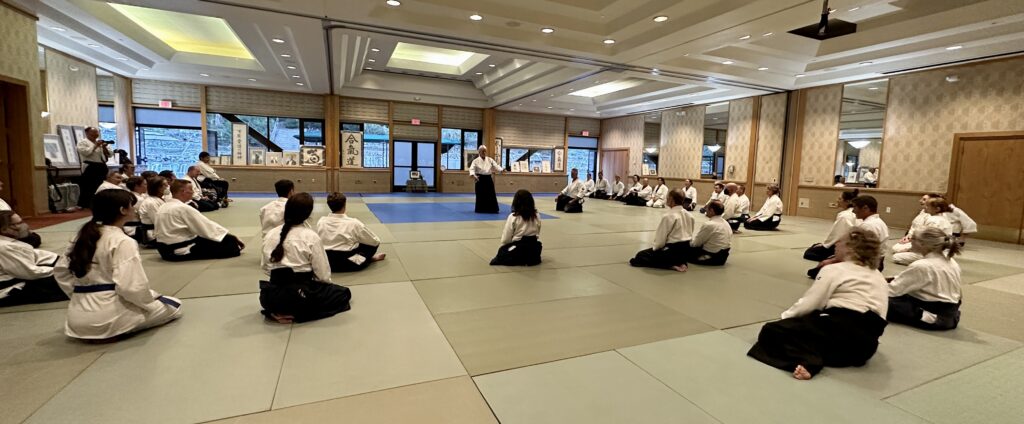
All of these are useful, and help us grow in our practice. Completely forgetting until next time we see it, on the other hand, doesn’t do us much good at all.
And many of the “aha moments” I experienced during today’s training involved ideas that were completely new to me. It is one of my favorite aspects of the art that there is no end of the learning that’s possible. There is no potential for boredom in Aikido! I didn’t want to forget these new ideas, either.
My Aiki Road Trip 2023
This post is part of a series: My Aiki Road Trip 2023. For about two weeks I’m sharing my adventures and photos on my way to the Aikido at Granlibakken retreat at Lake Tahoe, insights and fun during a week of great Aikido training with dear friends, and the trip back. I’m driving through the Mojave Desert, San Joaquin Valley, California’s Gold Country, and High Sierra, exploring the historic water situation — rivers, reservoirs, dams, flooding, and Tulare Lake, plus gold rush history, and amazing nature and scenery.
At the bottom of each post I include resources for further exploration about each day’s adventures – books, videos, maps, links, images, etc.. For the trip in general, here are more California History Resources for Road Trips.
I mostly posted these from my phone, with limited Internet access. There may be typos and glitches. I’ll come back to fix them later. You can email me at [email protected].
Taking a Few Notes
To help myself hang onto a bit from each class I usually take notes. I often do refer back to them, but even when I don’t, the process of keeping a few key points in mind long enough to write them down, and organizing them into words or illustrations helps me remember.
I can usually keep about three ideas in mind, often by repeating them to myself until I can get to my notebook. This is actually a working memory hack that I have learned is a common strategy among people with ADHD. It’s called chanting. You keep something in mind by saying it over and over. But it has its limits. Anything more than three or so and I start losing a few of them.
Once I get them down on paper, in the briefest summary I can manage, I often add symbols to help me remember why I thought it was important in the first place. My favorite is a checkbox. That means go back and do this. Try it when I get home.
A Few Insights from Saturday
One of the dangers, for me, in taking notes is that my tendency is to try to write down every how-to detail. Then I get bogged down in writing notes! So I have been making a conscious effort to only choose a few concepts or exercises from each class.
I skipped a couple of classes today, but here are some of the take-home ideas I gleaned from the others. This is by no means meant to be a representation of each instructor’s most important points, rather, it’s a sampling of the teachings that stuck with me in the moment.
Michael Friedl Sensei opened his class this morning with a reminder to train with a generous spirit – being sure to include people we don’t know yet, and newer students. It’s so easy to spot your friends in the crowd and run over to train with them, but we were off first timers or newbies at one point, so we all know what it’s like when people might seem to not want to train with you.
Friedl Sensei also demonstrated how turning one’s palm downward when being grabbed with a crosshand grab, what we call at our dojo gyakute-dori, helps lift Uke off their center as the reach for your wrist.
Craig Fife Sensei starting out with drills for teaching punching. He demonstrated how fully turning your punch so your palm is downward can put your elbow at risk if your partner knows just how to hit it at the right time. That was great information, and new to me, but what I really liked about the punching drills was how they helped me connect my hips to my movement, and helped connect back energy to front energy. The drawing back part of the movement is of equal importance to the punching part. I can see using these exercises as warm-ups, just to get my body more integrated before training.
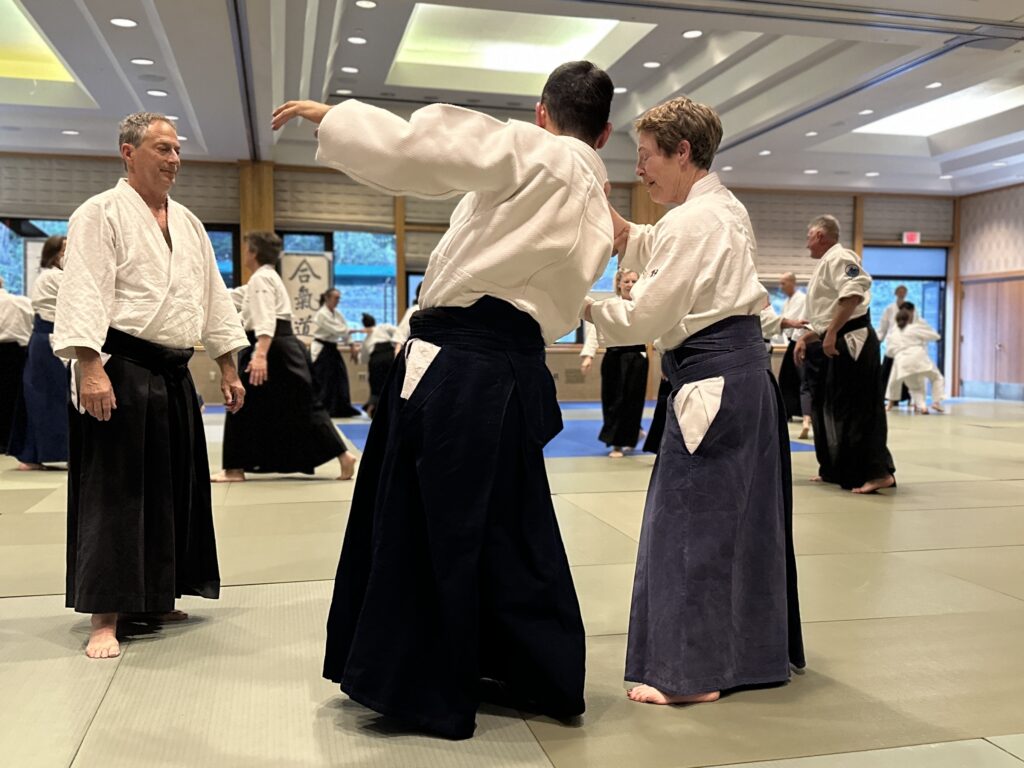
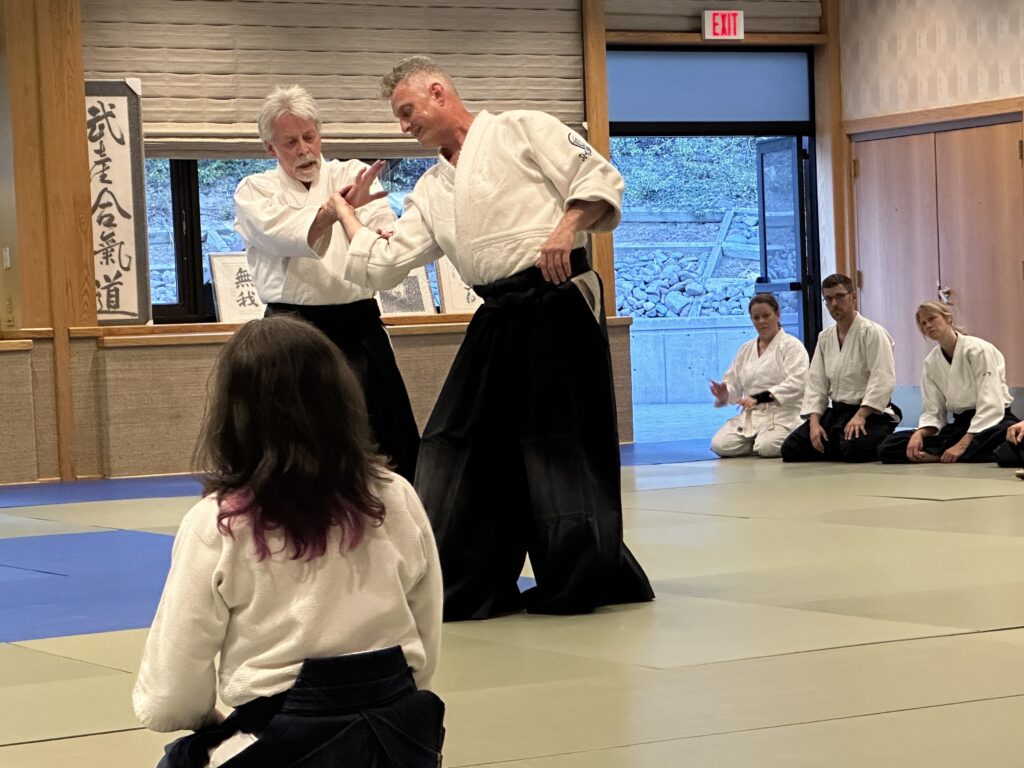
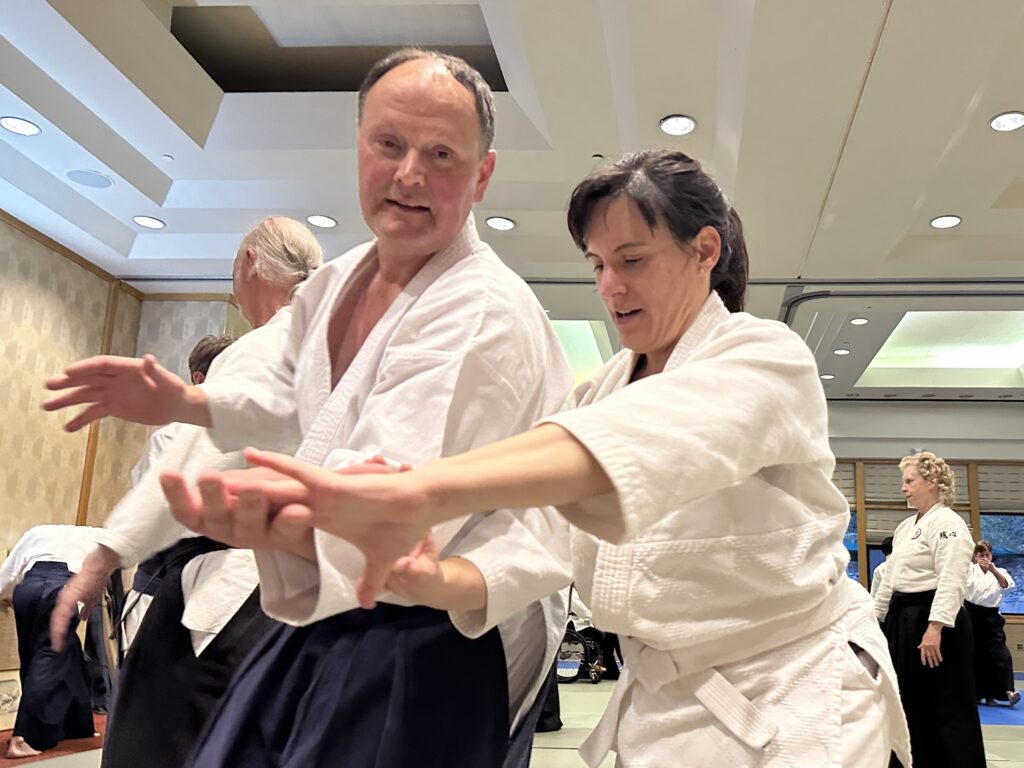
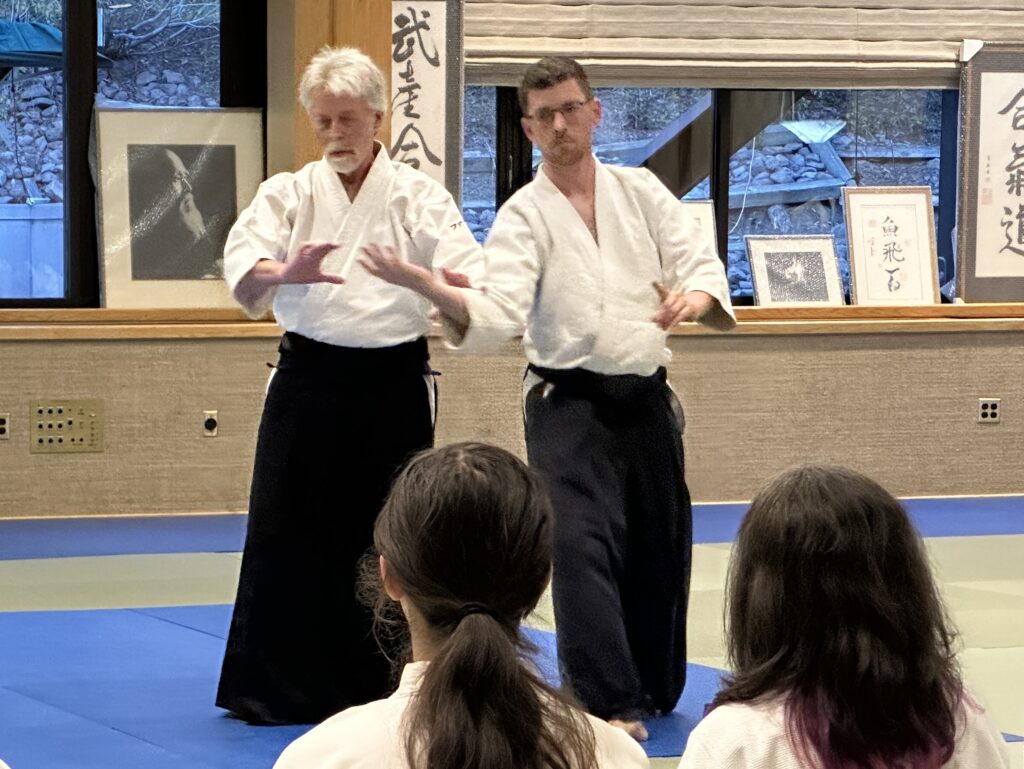
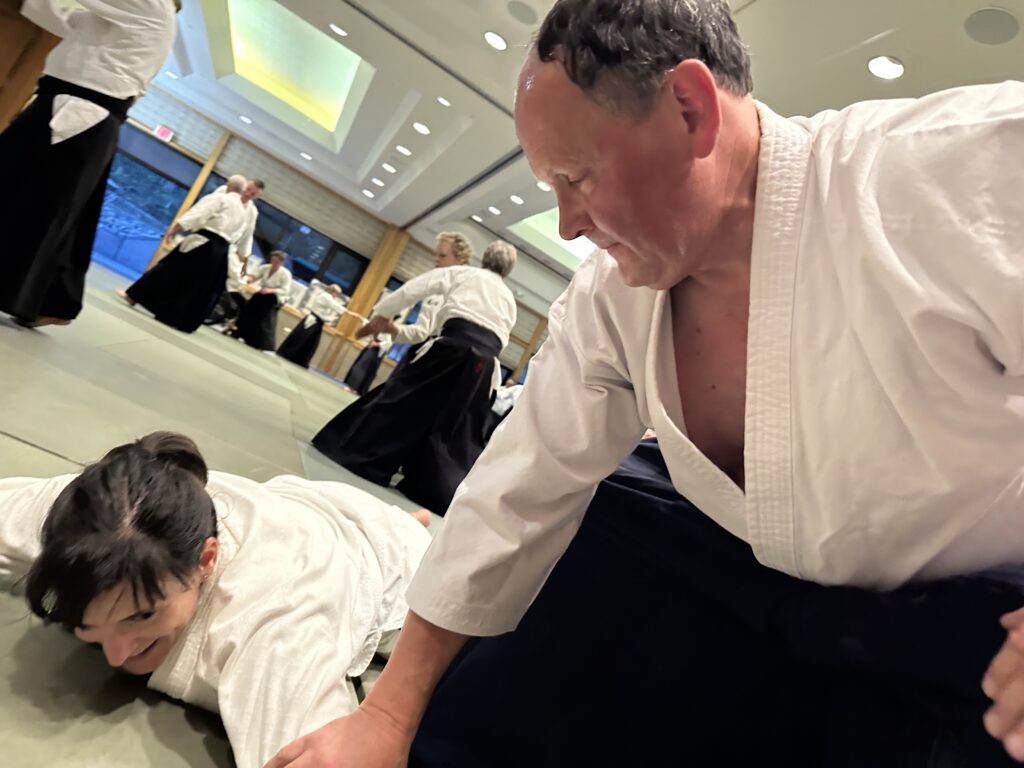
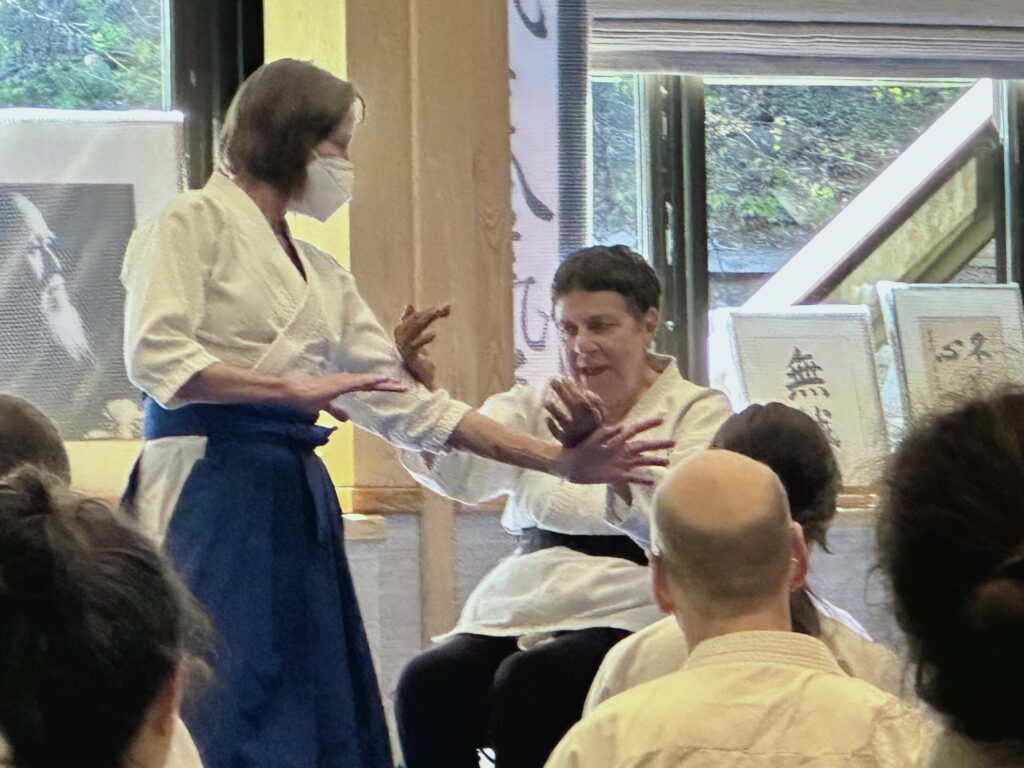
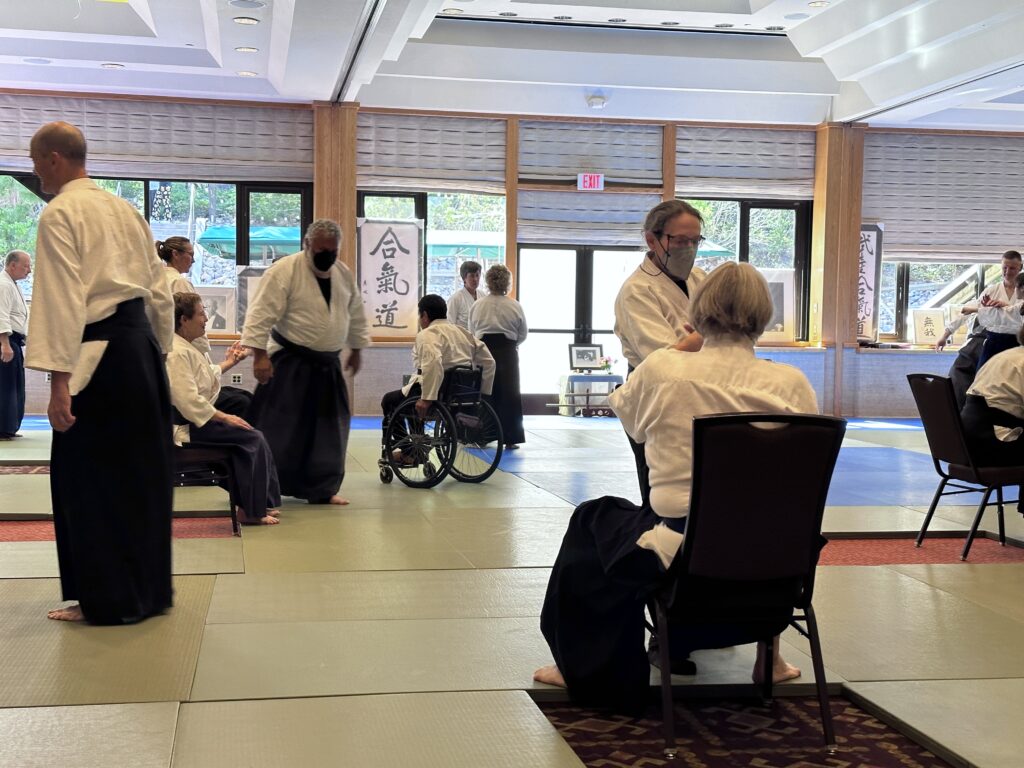
Molly Hale Sensei taught a class on blending with a punch from a seated position. For those who may not know her, Hale Sensei uses a wheelchair, so has a unique perspective on this. “Getting off the line of attack“ isn’t a possibility, so affecting the direction of the attackers energy is critical.
One of the points she made that most struck me was to keep your arms soft (a concept with which I am familiar) even all the way back into your shoulder blades (this was something I had never thought about). Give it a try! In whatever you are doing – Aikido, preparing dinner, or whatever. Try relaxing your hands and forearms. That’s nice. Letting go of a little tension is always a good experience. But now think of softening all the way up your arms and including your shoulder blades and upper back. Doesn’t that feel better!
That was just one little comment she made during her class, but I’m taking that one home with me and using it.
Sharing Meals and Connecting
Meals at this retreat typically involve good food, and are a great opportunity to catch up with old friends and get acquainted with new ones. The weather today was beautiful – cool and sunny – perfect for eating outside, which is definitely my preference. We are expecting thunder showers all the rest of the week, but I am hoping meals will happen between the rain storms.
Lunch was just OK — a jackfruit sandwich on gluten-free toast. The meat-eaters’ alternative was pulled pork on some sort of sturdy looking bun.
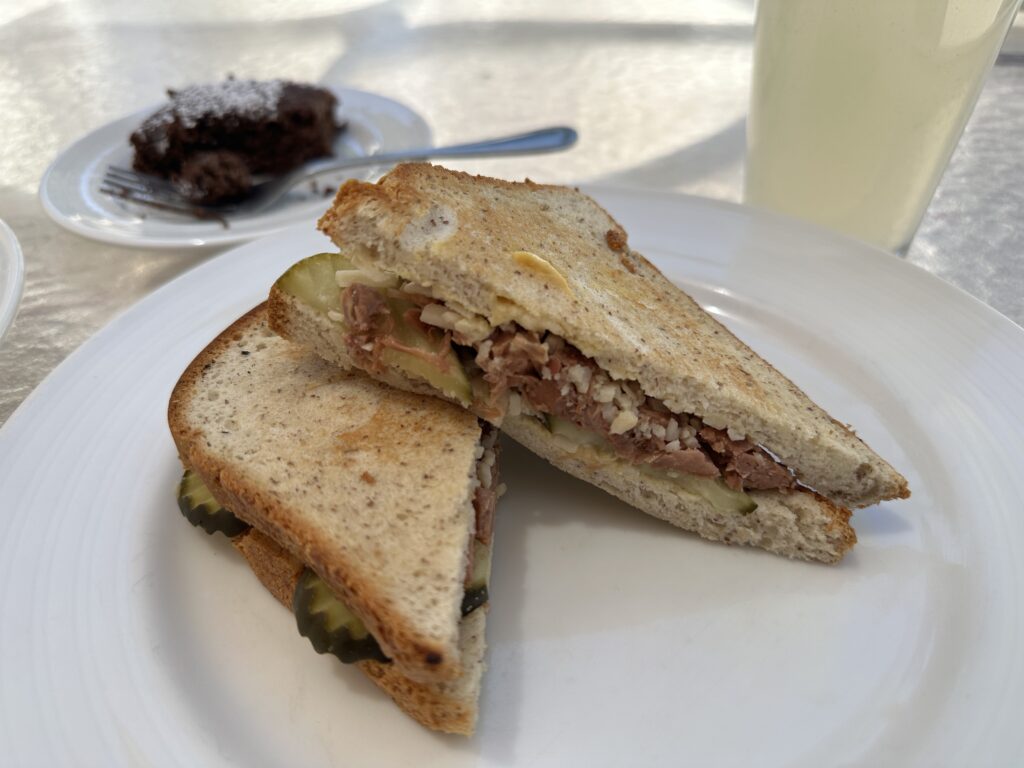
Dinner was my favorite meal so far – salmon and veggies! I was very happy to have some protein, and it was delicious. I have a stash of protein drinks in my room, just in case, but I will take grilled salmon over those any day.
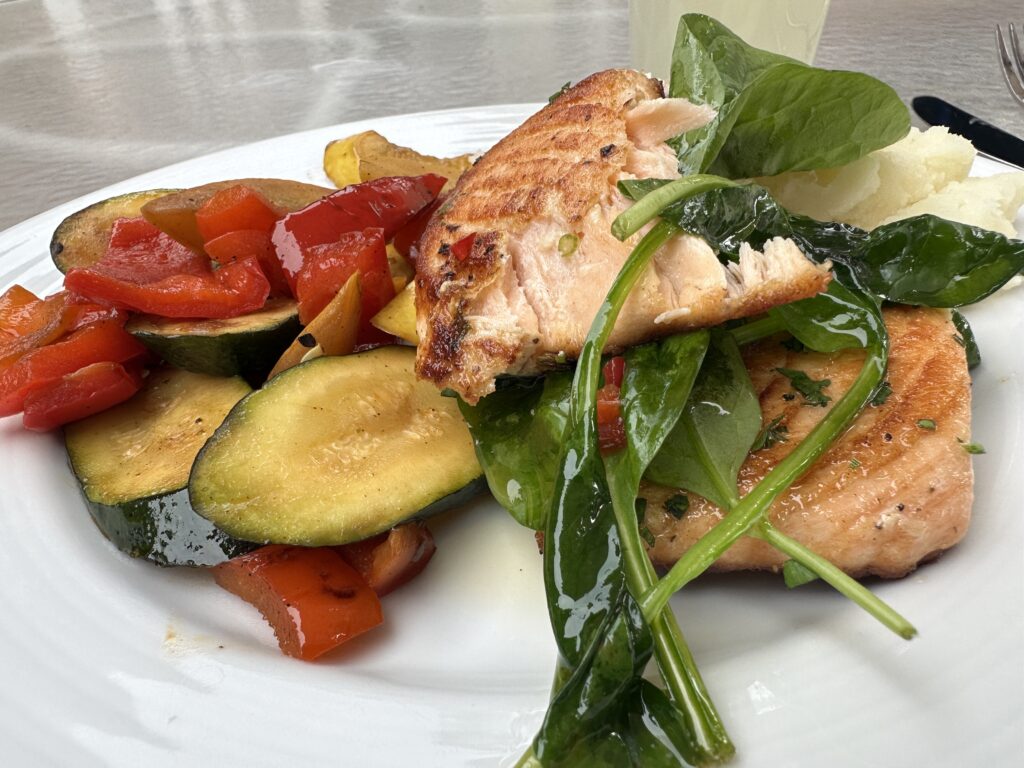
A Little About Granlibakken
The resort where this retreat is held is lovely. A combination of a lodge with hotel-like rooms, and also separate condos where several people, or maybe a dojo group, can share a household.
I have a single room in the lodge all to myself, which is the only way I was willing to do this, so I can avoid being in close quarters with others. We also can eat outdoors, which is wonderful. The weather has been perfect for it, too.
Granlibakken is an old-school mountain resort. The facilities and grounds are meticulously maintained. There’s a large pool, a hot tub that can accommodate 24 people, and a sauna. Thursday a small restaurant and bar that’s open in the evenings. It has a very comfortable rooftop patio and outdoor bar, too. At registration we were each given a handful of tokens good for beer or wine.
There are hiking trails, tennis courts, a small but well-equipped gym, a yoga room, and a ropes course for groups who want to do team-building exercises. During the winter months there is a large sledding hill with a rope tow (I think), and snow grooming equipment. It is dry and grassy right now.
I took all these photos from my balcony:
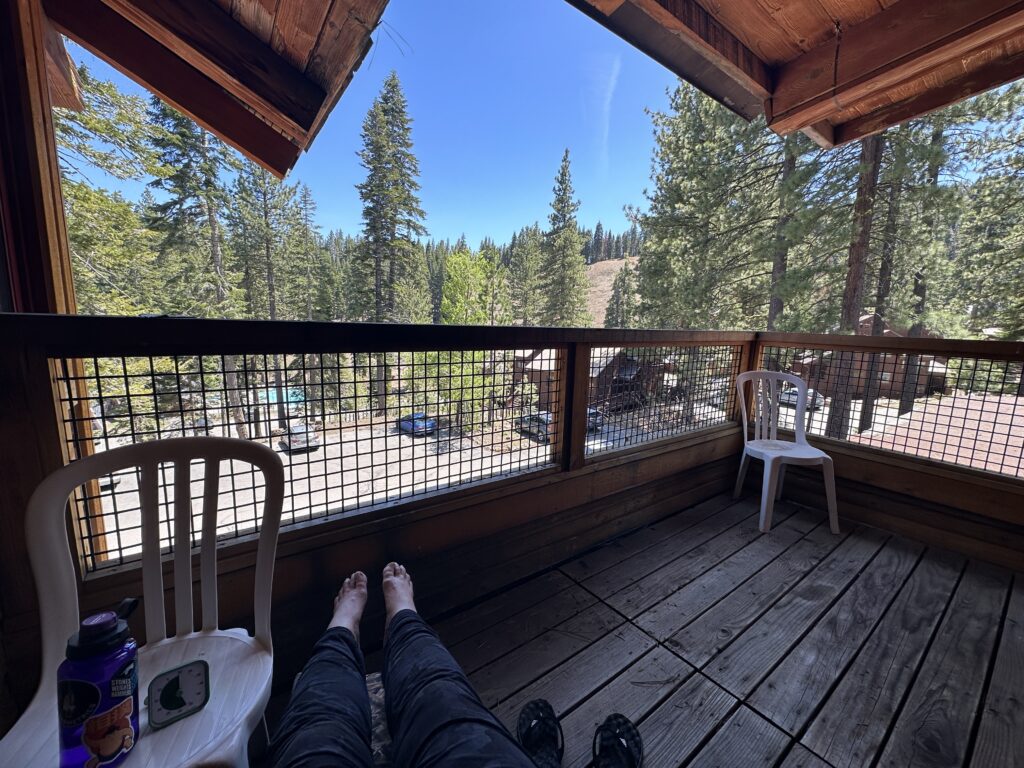

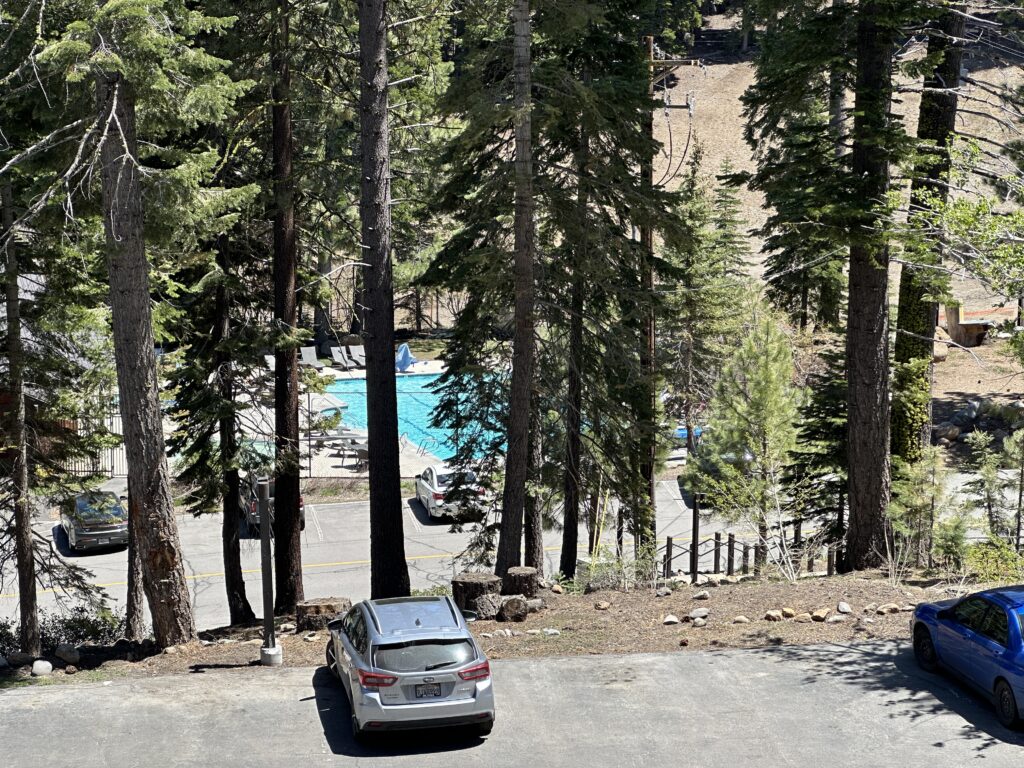
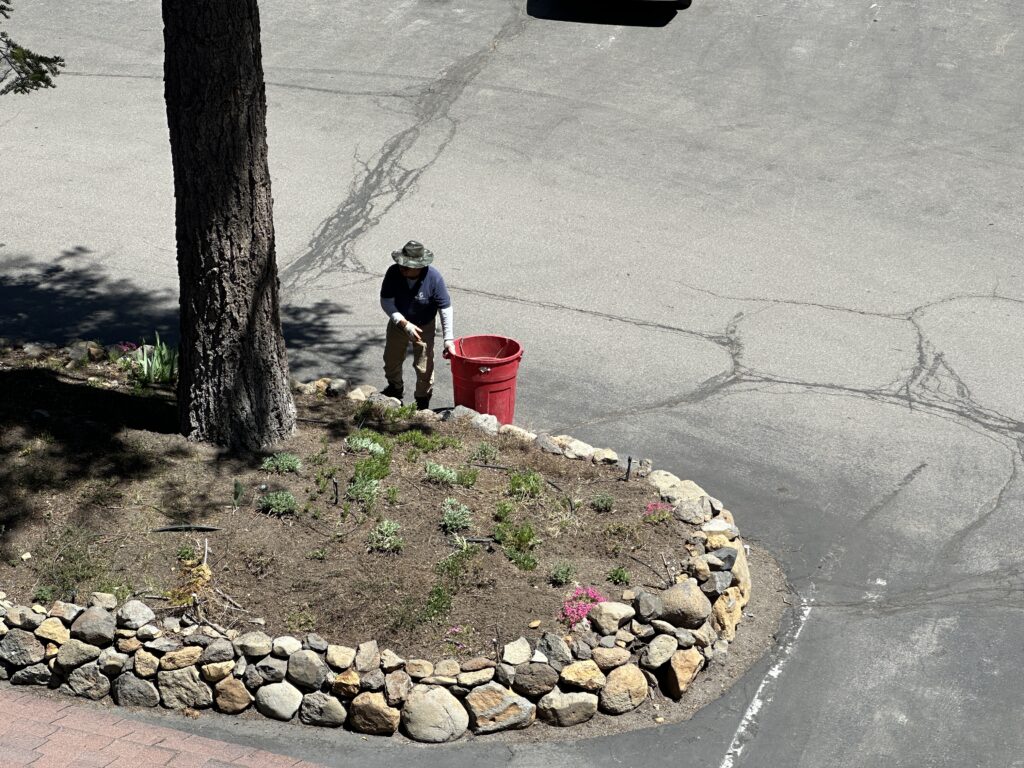
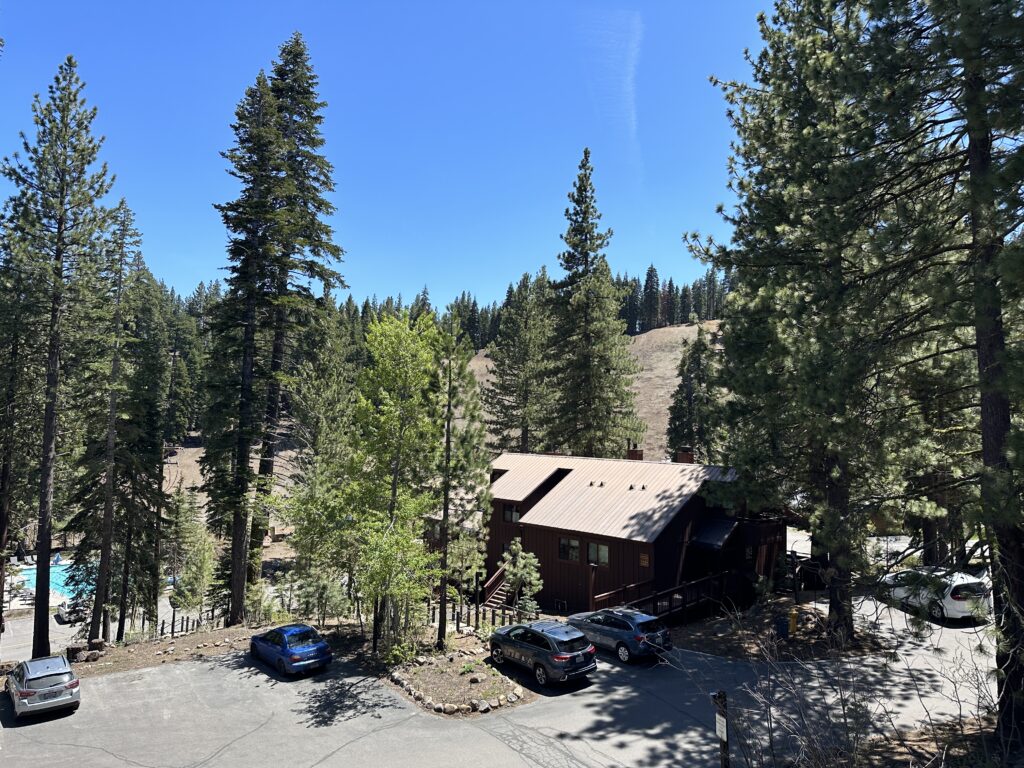
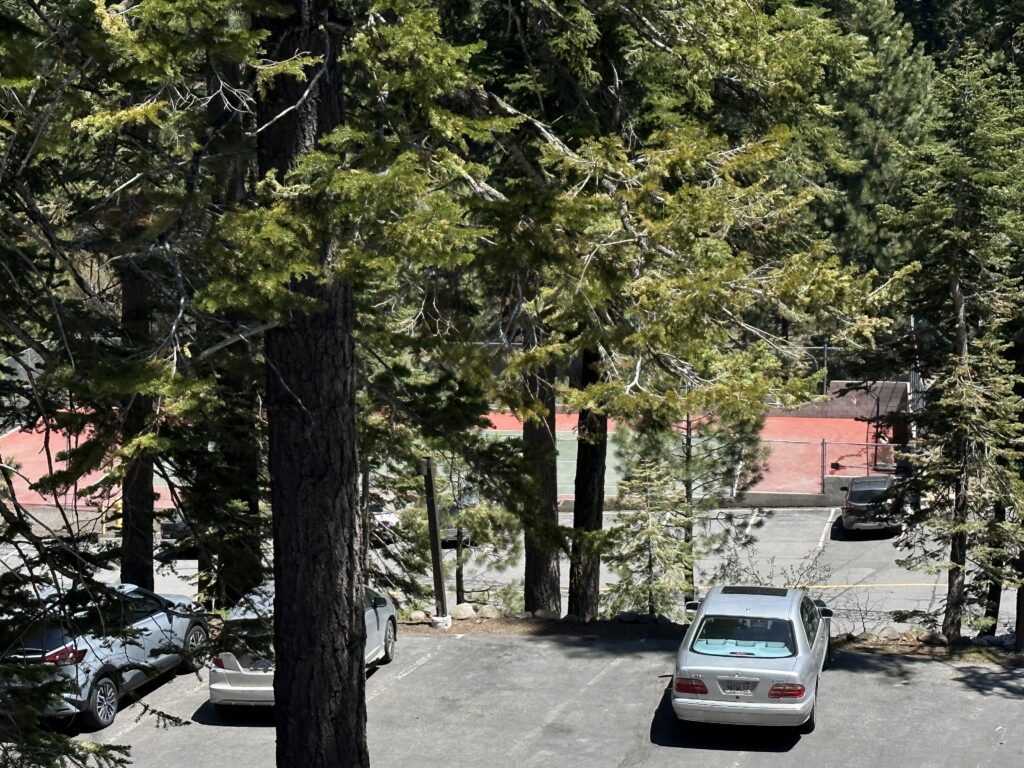
What’s Next?
Sunday will be very similar to Saturday – the same basic schedule, but with a few new teachers. I will still be skipping the 7 AM class. As much as I would love to be there, that’s just too early for me.
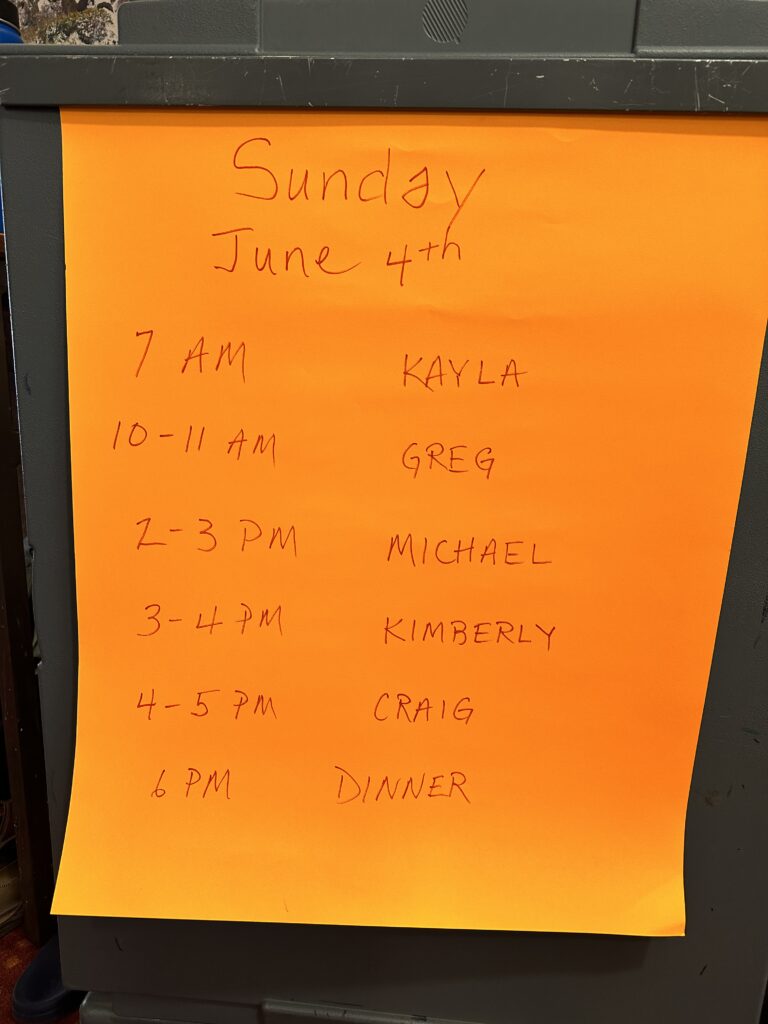
Time for a light breakfast, and then training at 10 o’clock.
A personal note: Saturday, June 3, was our anniversary. Michael and I were married in 1989, after being together already for nine years. So, officially it was our 34th wedding anniversary, but we’ve been together for 43 years. Either way, we will do something special to celebrate together when I get home from my road trip.
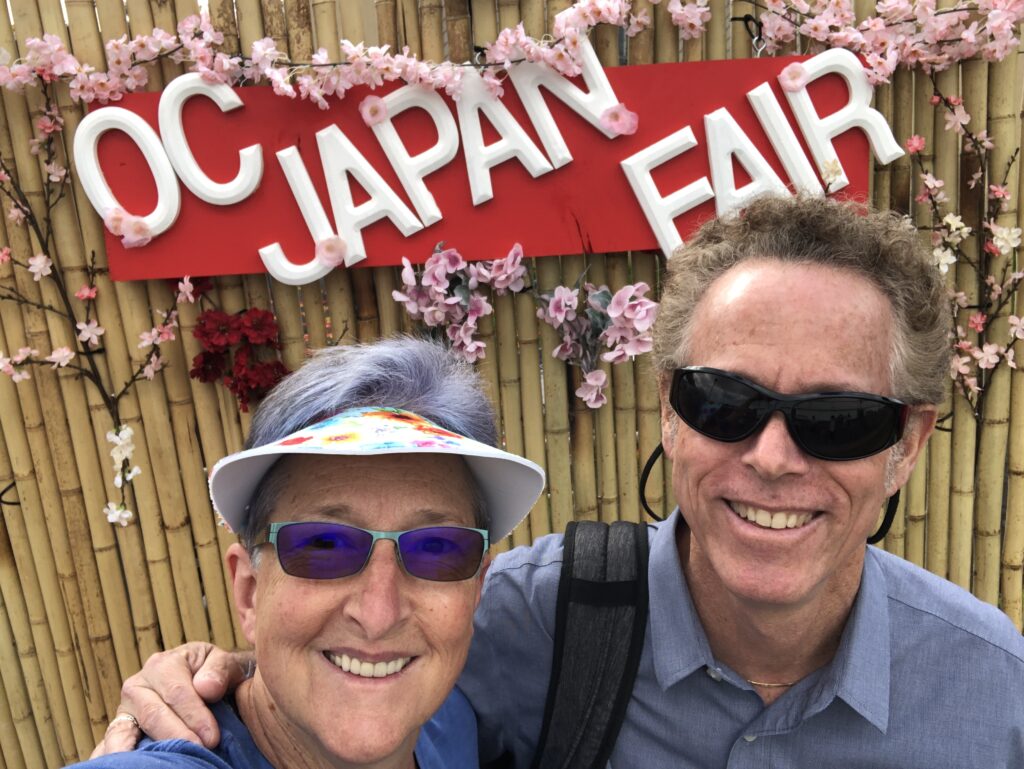
About the Author — Linda Eskin
Linda Eskin began practicing Aikido in 2009, at age 46. From the beginning she was inspired to explore how Aikido is taught and learned. In addition to mentoring adults, and now teaching a weekly Focus on Fundamentals class for students of all ranks, she assisted in the children’s programs for over eight years.
Linda loves Aikido both from the technical perspective, and as a practice of awareness and embodiment. She is completing her forthcoming book, Aikido to Zanshin – 26 Essays on the Martial Art of Peace.
Linda’s passion is encouraging people to begin, and supporting new learners of all ages.
Linda trains with Dave Goldberg Sensei at Aikido of San Diego, in California, and holds the third black belt rank, sandan.




